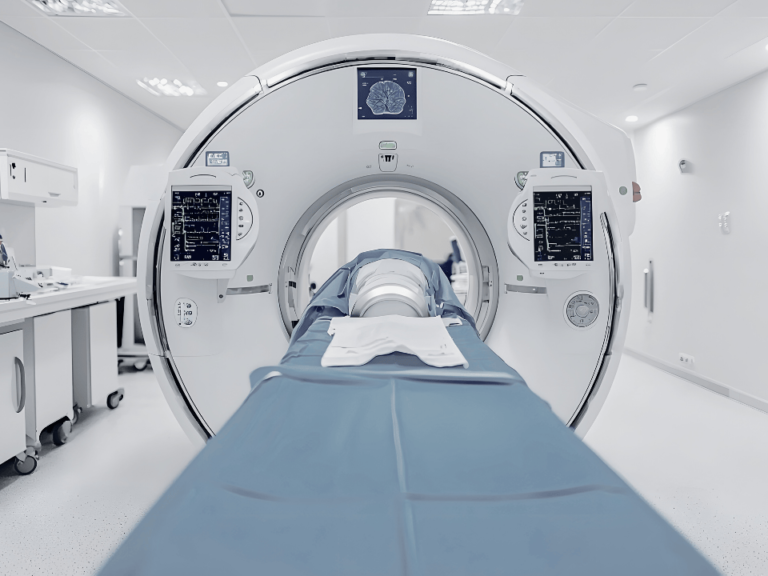An interview with patient activists Amy Reed and Hooman Noorchashm, first published July 4, 2014.
Nearly a year and a half after a surgical tool routinely used by gynecologists disseminated her undiagnosed sarcoma, Amy Reed found herself back in the operating room—this time for removal of a second metastasis.
Reed’s leiomyosarcoma, which had been in remission after a massive surgery and post-morcellation chemotherapy, has spread to her lumbar vertebrae.
A mother of six, Reed, 41, is an assistant professor of anesthesia and critical care medicine at the Hospital of the University of Pennsylvania.
Reed and husband Hooman Noorchashm led a national campaign against the gynecological procedure.
“Amy had a big operation, and is undergoing radiation therapy,” said Noorchashm, formerly a cardiothoracic surgeon at Brigham & Women’s Hospital who now practices at Thomas Jefferson University Hospital. “She had to sacrifice an L2 sensory nerve and fuse two vertebrae in that operation.”
The couple’s travails began on Oct. 17, 2013, when Reed’s uterus was removed via power morcellation at Brigham & Women’s. Spread by the spinning blades of the device, within days, Reed’s undetected sarcoma metastasized in her abdominal cavity (The Cancer Letter, July 4, 2014).
When Reed first went into surgery, she and Noorchashm had no idea that power morcellation was the standard method for removal of fibroids and hysterectomies.
It was performed on an estimated 100,000 women in the U.S. each year.
The media campaign Reed and Noorchashm conducted in the aftermath of their personal ordeal brought urgency to what ordinarily would have been an obscure debate among subspecialists. Hospitals, physicians, and minimally invasive gynecological societies scrambled to address the controversy.
Within a year, FDA decreed that power morcellators are contraindicated for hysterectomies or fibroid removal in the vast majority of women getting these procedures—essentially ending power morcellation as a standard practice (The Cancer Letter, Nov. 26, 2014).
“We have come a very long way,” Noorchashm said. “For the most part, however, I think the morcellation fight has been quelled.”
“We’re going back down to the FDA on April 21 to talk about device regulation,” said Reed, formerly an anesthesiologist at Beth Israel Deaconess Medical Center. “Other than that, we’ve been keeping busy with the six kids—soccer, basketball, gymnastics, lacrosse, and school.”
Climbing Numbers
Clinical practice and payment policy changed rapidly as a result of the couple’s advocacy.
FDA estimated that Reed’s is not an isolated case. About one in 350 women who are undergoing hysterectomy or myomectomy for fibroids is found to have an unsuspected uterine sarcoma, the agency says.
The American Association of Gynecologic Laparoscopists disagrees with the estimate, citing international data reporting lower prevalence rates.
However, a study published last December indicates that the risk may be twice as high as the FDA estimate.
A retrospective review of medical records for 3,523 women by Jasmine Tan-Kim and colleagues from Kaiser Permanente San Diego found that about one in 156 women who underwent laparoscopic hysterectomy with power morcellation were diagnosed with uterine sarcoma. The paper was published in the American Journal of Obstetrics and Gynecology.
A more recent study puts the incidence of unexpected gynecologic malignancy—uterine sarcoma and endometrial cancer—at 2.7 percent. Nichole Mahnert, a clinical lecturer of obstetrics and gynecology at the University of Michigan, led the study, which reviewed records for 7, 499 women who underwent a hysterectomy in 2013.
Other studies support FDA’s estimate: a study by Andrew Brohl et al. at the Icahn School of Medicine at Mount Sinai found that the overall aggregate risk of unsuspected uterine sarcoma was 1 in 340. Published in The Oncologist March 12, the retrospective study pooled data from eight studies conducted between 1980 and 2014, with a total sample of 10,120 patients.
A large study of 36,470 women by Columbia University physicians, published in JAMA July 2014, found that the risk was one in 368 women.
“Several studies have come out that—beyond a shadow of a doubt—demonstrate that the rate is somewhere in the one to 200 to one in 500 range,” Noorchashm said. “That’s not disputed any longer.”
The Question of Cost
A study published April 10 in the Journal of Minimally Invasive Gynecology argues that power morcellation is more cost-effective than other procedures.
“Eliminating morcellation hysterectomy as a treatment for fibroids is not cost-effective under a wide variety of probability and cost assumptions,” the authors concluded. “Performing laparotomy for all patients who might otherwise be candidates for morcellation hysterectomy is a costly policy from a societal perspective.”
Led by Pietro Bortoletto, a senior advisor for the Chicago Life Science Consortium, the study compared the cost for preventing disseminated cancer to the overall savings from using power morcellators for the removal of fibroids—on a societal scale.
Bortoletto’s decision analysis model provoked swift outrage from Reed and Noorchashm.
“I’m really struggling with the whole ethics of what the OBGYN community has been publishing lately,” Reed said. “They’re completely missing the point, over and over and over again.
“That is actually shameful. What do you mean by cost effective? Cost effectiveness in this context is shooting everyone over the age of 80, because they cost the health care system a lot. That’s not medicine.
“There is no cost effectiveness to killing a small subset of people to preserve the health of others. That’s atrocious. If the OBGYN community stands behind that, they should be stripped of their medical licenses.”
Added Noorchashm: “Am I hearing this right? These minimally invasive gynecologists are actually justifying the sacrifice of a minority subset of lives from cancer upstaging to save costs?
“America went to war to stop fascism, perhaps its time for Congress to step up and eliminate this kind of perverse ideology from the American corporate ethos.”
Congressional Pressure
FDA categorizes the power morcellator as a Class II moderate-risk surgical device, which means that it was cleared for the market based on comparability to predicate devices already in use, according to the 510(k) process.
Only Class III high-risk devices are subjected to a rigorous FDA premarket approval application process.
The couple’s lobbying efforts have been productive as well.
Two members of Congress—Sen. Robert Casey (D-Penn.) and Rep. Michael Fitzpatrick (R-Penn.)—have begun an inquiry into FDA’s processes for clearing devices such as the power morcellator.
In a five-page letter dated Feb. 19 and addressed to the FDA Commissioner, Fitzpatrick put forward 23 questions about the 510(k) process and consumer protection mechanisms at the Center for Devices and Radiological Health, which is responsible for the premarket approval of all medical devices, as well as overseeing the manufacturing, performance and safety of these devices.
“I write to seek clarification of your agency’s regulation of medical devices,” Fitzpatrick wrote. “I am specifically looking to obtain answers about the 510(k) process, and hoping to gather information about whether the FDA has plans to alter this process in light of recommendations from the Institution [sic] of Medicine.”
FDA and Congress asked the Institute of Medicine to review the 510(k) process in 2009. The committee unanimously concurred that the process was defective, and that it should be replaced.
In a similar push, Sen. Casey inquired about FDA’s response to the concerns that have been raised about the safety of power morcellators. FDA has not responded to the Fitzpatrick and Casey at the time of writing.
The letters can be downloaded here.
FDA’s CDRH is responsible for safeguarding the public from potentially harmful devices, Noorchashm said.
“It’s the 510(k) process, but it’s also more than that,” Noorchashm said to The Cancer Letter. “The mission of the CDRH is to streamline entry of lifesaving devices into the marketplace. That’s a very different mission than insuring public health, and in the public health equation, that’s a mistake. The industry is not the public. The public is the primary and foremost stakeholder.”
Noorchashm takes pains to explain that neither he nor Reed are anti-business.
“I’m pro-industry and pro-business, but the argument here is very clear-cut,” he said. “Here’s the thing about the public—the public who isn’t affected is usually not informed enough to fight, so they’re not going to really engage in the democratic process with respect to this particular topic.
“The part of the public that’s harmed is usually very hurt, very bankrupt or very dead, which effectively dissociates them from the democratic process.
“That leaves the lobbyists, and that leaves the industry. When the CDRH, instead of focusing on the public’s interest as the primary and only stakeholder, focuses on the interests of industry or the lobbyists as an equal stakeholder, industry and lobbyists win.
“So it’s not because our federal government is failing. It’s because specific individuals within CDRH and FDA leadership have forgotten what their mission is.”
Insurance Providers Limit Coverage
Two insurers—Health Care Service Corp., and UnitedHealth Group Inc.—have placed limitations on their coverage for power morcellation.
In a policy that went into effect April 6, UnitedHealth, the nation’s largest insurer with 40 million customers, requires doctors to obtain authorization from the insurer for all hysterectomies except outpatient vaginal procedures, which do not use power morcellators.
Recently, Health Care Service Corp., the fourth largest at almost 15 million customers, proposed labeling power morcellation as “not medically necessary.” This typically means that the procedure would not be eligible for coverage. The draft policy is open to public comments before a decision June 1.
Aetna Inc. is considering changes in its coverage and will complete its review end of April, according to a spokesperson. At 23 million customers, Aetna ranks third.
Other insurers, including Blue Shield of California, UPMC Health Plan, Blue Cross Blue Shield of Massachusetts, HighMark Inc. and AmeriHealth Caritas, ceased or limited coverage by the end of 2014.
“As far as we are concerned, we have raised an alarm, and we’ve let the public know,” Noorchashm said. “Whether our Congressional and corporate leaders, and citizens of this country are capable of looking at it and recognizing this, it is the question.
“It’s up to them to decide.”
Upcoming Litigation?
Reed and Noorchashm, who both have doctorate degrees in immunology, are studying the disease.
“The recurrence gave us an opportunity to look a little more carefully in the lab,” Reed said to The Cancer Letter. “If I continue to feel better, I’ll be able to get back in there and study the immune response to my tumor, or lack thereof.”
Added Noorchashm: “If you will, we’re basically on an island that’s on fire. And we’re trying to use whatever information we have to build a raft and get away as fast as we can, or we will be engulfed by the flames.”
Noorchashm said he has informed the Department of Justice and the Federal Bureau of Investigation about the power morcellator.
His argument: manufacturers of the device and hospitals that use it have violated federal law—specifically, Section 803 of Title 21—by neglecting to report adverse events.
This argument is reflected in a letter from Rep. Fitzpatrick to FDA.
“Does FDA have a legal and prosecutable ‘positive mandate to self-report adverse outcomes in the medical device space’ for individual practitioners, [hospitals, and device manufacturers]? If so, have there been any prosecutions for failure to report?” Fitzpatrick inquired in the letter.
In the course of his campaign against power morcellation, Noorchashm has fired off thousands of emails to regulators, academics, hospitals, legislators and journalists.
In a recent email to his former colleagues at Brigham & Women’s, Noorchashm said DOJ and FBI are getting involved.
“I will look forward to your federal subpoenas,” Noorchashm wrote March 13, as Reed was recuperating from her lumbar surgery. “Very certainly after the first fatality at the Brigham from this complication, you should have stopped. You did not.”
Brigham had seen adverse events related to power morcellation before Reed’s surgery.
At the time Reed was recuperating from her hysterectomy, another patient, Erica Kaitz, was dying from metastatic disease. Kaitz died on Dec. 7, 2013, nearly two months after Reed received her diagnosis (The Cancer Letter, Nov. 21, 2014).
Patients across the U.S. were subjected to power morcellation without being informed of the cancer risk. The risk had been described in medical literature, but was often underestimated.
“So I will only assure you, that not only will the civil court system query your negligence in practice, but the FBI and the U.S. attorney’s office are now looking with eyes wide open,” Noorchashm said in the email.
“Do not mistake me for a ‘distraught patient family member.’ Remember, I am one of you, and I know what you have done and why you did it.”
DOJ and FBI didn’t respond to questions from The Cancer Letter. Brigham & Women’s Hospital declined to comment.
The next battle in the ground war on power morcellation will be fought in the courts, Noorchashm said.
“I think that negligence will be demonstrated,” Noorchashm said to The Cancer Letter. “Once that’s done, and once several millions of dollars are lost, I think most institutions will think twice about doing this.”
Medical device safety is a national health and economic security issue, Noorchashm said.
“We’re very good at talking about threats to the security of our nation, we’re very good at going 5,000 miles away and saying, ‘ISIS does this, ISIS does that,’ but when something clear-cut like this comes out in our own system, we are virtually paralyzed at solving it. That’s not right,” Noorchashm said.
“Amy alone—one patient, one device—she had a $30,000 operation, which has, up to date, cost about half a million dollars in follow-up care. You take that, and you integrate that over all the people that have been hurt over 20 years—the cost to the insurance infrastructure will be in the billions of dollars. And this is just one device.
“There is no real safety testing to make medical devices in this country safe, and the morcellation example is the bellwether case for that.”











